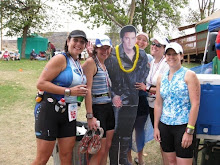Posted on Oct 12th 2010 1:00PM by That's Fit Editors
We've followed all of the weight-loss rules, trading our lunchtime burger and fries for a salad, cutting back on snack foods and sweets, choosing fat-free over full-fat whenever possible. So if we're doing everything right, why is the needle on the scale stuck -- or worse, moving in the wrong direction?
Even when we have the best of intentions, something as simple as a healthy but oversize snack can make us gain weight rather than lose. But finding small ways to save just 100 calories a day can take off 10 pounds in a year. With help from a few nutrition experts, we've put together this list of red-flag foods and some simple strategies to keep them from undermining your weight loss efforts.
1. PRE-MEASURED PACKS
Are 100-calorie snack packs a part of your stay-slim repertoire? As it turns out, these pre-portioned treats may do more harm than good. When researchers from the Netherlands gave TV-watching students either two large bags of potato chips or several portion-controlled ones, those with the smaller bags ate twice as many chips. If you find yourself reaching for a second 100-calorie bag, leave the empty pack in plain sight: Previous research has shown that people consume less food when they can see what they've already eaten.
[That is me! I will want a second bag, then feel the need to finish it. Plus, these snack packs are a waste of packaging and end up in the landfill. - L]
2. "DIET" TREATS
Fat-free and sugar-free don't necessarily mean low calorie. For example, one brand of reduced-fat chocolate chip cookie supplies 47 calories -- just 6 less than a regular cookie. Plus, studies show that people who are overweight take in twice as many calories when they eat low-fat snacks rather than the regular versions. If you have a cookie craving, advises Katherine Brooking, RD, a New York City-based dietitian, go for the real thing -- but limit yourself to about 150 calories' worth.
3. LIQUID CALORIES
A couple cups of cappuccino (each with two teaspoons of sugar) and a couple of cups of tea (each with two teaspoons of honey) add up to 150 calories in sweetener alone. Brooking recommends making do with less sweetener or switching to a zero-calorie alternative, like Splenda. Watch out for alcoholic beverages, too. Replace wine or beer with flavored club soda or sparkling water, and you can save big on calories.
[Bleh on Splenda. Why would you do that to yourself? Start by ordering a mocha with only 1 pump of chocolate, then add some cinnamon on top. - L]
4. SUPER-SNACKS
Eating every few hours is a good way to keep your metabolism humming, but it's easy to consume too many calories if you aren't careful. Snacks are the main culprits, particularly if they are too big and too frequent, explains Dawn Jackson Blatner, RD, author of The Flexitarian Diet. Limit yourself to just two snacks a day, at about 150 calories each. And be wary of relying on energy bars as snacks; some deliver as many as 400 calories each. As a rule of thumb, a bar under 200 calories is a snack, Blatner says; anything above that counts as a meal.
[This is my main problem. I know snacking is good, but then I'll snack and snack and pretty soon it adds up to a lot of calories! So what helps me is to plan my snacks in advance, and make them balanced in protein/carbs/fat. More of a mini-meal. And gawd knows I love my bars - LUNA Bars, LUNA Protein, and Think Thin! But those I'm trying to get away from - condensed calories! - L]
5. RICH PROTEINS
Stick with lean proteins because higher-fat versions can have twice as many calories. Even if you measure the proper serving size, just three ounces of sirloin supplies 225 calories, nearly half of which come from fat.
By comparison, the same amount of skinless turkey contains 144 calories, only 10 of which come from fat. And turkey sausage has 75 percent less saturated fat than pork sausage. Other lean protein choices include fish and beans.
6. FAT-FREE SALAD DRESSINGS
Many of us reach for boastful labels like "reduced fat!" and "fat free!" but it turns out that manufacturers often replace the fat in these products with sugar, which means that your dressing still may be loaded with calories. Ironically, a salad without fat is not living up to its potential. You need a little fat to absorb vitamins A, D, E, and K and other nutrients, so use smaller amounts of oil-based salad dressings instead. You'll get good-for-you fats rather than the saturated fat found in some creamy dressings. Look for ingredients like olive oil, vinegar, and herbs.
7. BAKED POTATO CHIPS
Yes, they're lower in fat. They're also high in calories but low in nutrients, with little fiber to fill you up. A better snack choice: popcorn. You'll get the salt and crunch of the chips in this whole grain, plus a healthy dose of fiber, all for about 65 percent fewer calories per cup. Look for oil-free microwave popcorn or brands that are airpopped or popped in healthful oils such as olive or canola. Adults who munch on popcorn consume up to two and half times more whole grains than those who don't, according to a recent study published in the Journal of the American Dietetic Association.
[Popcorn is a great idea! - L]
For more healthy living tips, check out the "List-Maker's Get Healthy Guide" -- it's packed with 96 lists that are fun, informative and get to the heart of the quickest, easiest ways to maintain a healthy lifestyle. Enter to win a copy here.





















No comments:
Post a Comment